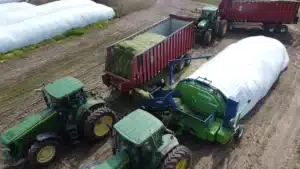With your forage being more valuable than ever before, it is important to feed forage to maximize their full potential, whether that means feeding high protein forages to your top lactating cow group or feeding rained-on third crop alfalfa to your replacement heifers. Ag-Bagging means you have more flexibility to store a variety of forages such as cover crops, alfalfa, grass, BMR corn silage or sorghum sudan.
With Ag-Bagging, many customers and dairy nutritionists use forage bags as a tool to best manage forage feedout and inventories on dairies.
Ag-Bag by RCI interviewed Gerrit DeBruin, owner of Prescription Premix, an independent nutrition consulting business based in Lake Mills, WI, how he manages forage bags with his dairy producer customers.
“Yes, I recommend segregating forages all the time with bags. You can do a really good job of managing forages with forage bags, “said DeBruin. “Sometimes, it means stopping the bag and starting again, but it also means that you have better cow performance, better health and better milk components.”
When his customers are harvesting forage, he recommends his customers mark the sides of the bag when different crops or conditions are being harvested. DeBruin shared that it is easy to analyze the forage after the crop has fermented inside the bag.
“We probe bags, take a sample, and analyze the forage in order to have a plan. We need to look ahead and see what our forage quality is to know how to best feed out these forages. We can feed different things at various times to maximize the forage quality on that dairy,” said DeBruin.
“One of the things I see is when you are managing forage inventories, it is best to have a bag ferment for 30-days before you feed it. It allows the bag to fully complete the fermentation process, and it is a good practice for overall cow health and quality,” shared DeBruin.
Within the Ag-Bag, your high protein forages can be segregated and used specifically for highest producing lactating cow diets. In doing so, your high protein forages can offset the use of high protein feed byproducts resulting in lower cost rations while achieving high milk components.
Ag-Bag dairy producer customers know how important segregate forages can be to their overall dairy health and milk production. Klink Dairy, located in Hartford, WI, milks 240-cows and has been Ag-Bagging their forages for over 21-years. Phil Klink, owner, discussed how they have been marking their forage bags to manage their feed inventory for years.
“We do mark our bags with the crop type and cutting. We will also mark it if it is wetter or dryer, so we know when we are feeding out the bags. We will evaluate the forage, and then adjust the ration accordingly to make the most out of our forage,” shared Klink. “And if we do have a field that gets rained on, then I can set that bag aside for my heifers to feed out.”
By storing forages with an Ag-Bag, it allows forage producers the flexibility to manage their forage inventories, maximize the forage potential, and restrict lower quality forage to specific cow groups. Segregate forages can provide much value for dairy and beef operations.

